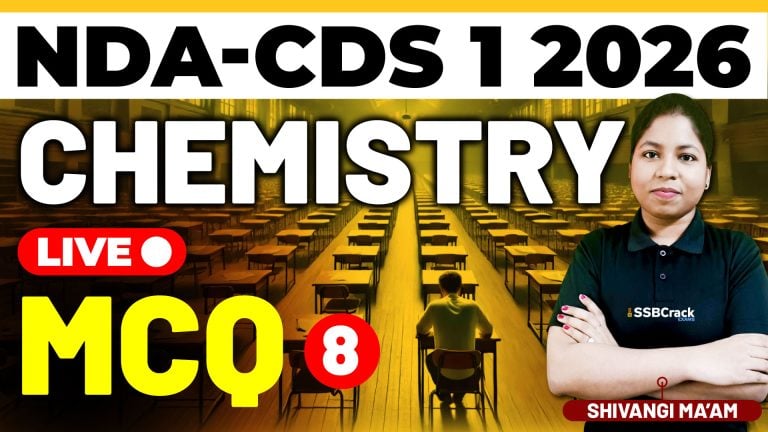Electricity is a vital part of Physics, often tested in competitive exams like the National Defence Academy and Naval Academy (NDA-NA) and Combined Defence Services (CDS) exams. Its practical applications and theoretical foundations make it one of the most engaging and scoring sections in these exams. A recent class focused on building a robust understanding of current electricity by covering essential subtopics and practicing conceptual problems. Here’s a detailed overview of the session and strategies to master this topic.
Highlights of the Class
The session revolved around key subtopics of electricity, aimed at making students confident about tackling related questions in the exams. Here’s a breakdown of what was covered:
1. Electric Current
The class began by discussing the concept of electric current:
- Definition of current and its flow in a conductor.
- The importance of understanding current in practical circuits.
2. Ohm’s Law
Ohm’s Law was highlighted as a foundational concept:
- The relationship between voltage, current, and resistance.
- Practical examples to help students relate the concept to real-life scenarios.
3. Resistance and Resistivity
The discussion moved to resistance and resistivity:
- Factors affecting resistance, such as the material, length, and cross-sectional area.
- How resistivity helps classify materials as conductors, insulators, or semiconductors.
4. Combination of Resistors
Students learned about the two primary ways resistors are combined in circuits:
- Series Combination: How the total resistance increases.
- Parallel Combination: How the effective resistance decreases.
5. Kirchoff’s Laws
Kirchoff’s Laws were explained to analyze complex circuits:
- Kirchoff’s Current Law (KCL): The principle of current conservation at junctions.
- Kirchoff’s Voltage Law (KVL): The conservation of energy in closed loops.
6. Cells and Internal Resistance
The class covered the role of cells in providing electrical energy:
- The concept of internal resistance and its impact on circuit performance.
7. Combination of Cells
Students explored how to combine cells for efficient energy delivery:
- Series Combination: For higher voltage.
- Parallel Combination: For better current supply.
8. Electrical Energy and Power
Electrical energy and power were discussed in detail:
- Understanding how energy is consumed in circuits.
- The importance of power ratings in appliances.
9. Heating Effect of Electric Current
The class delved into the practical implications of the heating effect:
- Everyday examples, such as electric heaters and fuses.
- The role of this effect in domestic circuits.
10. Domestic Electric Circuit
Finally, the class discussed the design and safety aspects of domestic circuits:
- Components like fuses, switches, and earthing.
- Precautions to prevent electrical hazards.
Strategies to Prepare for the Topic
Electricity is a concept-heavy topic, requiring a clear understanding of theory and its application. Here are some strategies to excel in this section:
1. Understand the Basics
Start with the fundamental concepts of current, voltage, and resistance:
- Visualize current as the flow of water through a pipe, with voltage as the driving force and resistance as the obstacle.
2. Master Key Laws
Familiarize yourself with laws like Ohm’s Law and Kirchoff’s Laws:
- Practice their application in simple and complex circuits.
- Use diagrams to simplify circuit analysis.
3. Practice Circuit Problems
Solve a variety of circuit-related problems:
- Focus on resistor and cell combinations to understand how they affect overall circuit performance.
- Work on questions that test your ability to apply Kirchoff’s Laws.
4. Relate to Real-Life Applications
Connect theoretical concepts to practical examples:
- Observe how resistors are used in electronic devices to control current.
- Understand the importance of fuses and earthing in domestic circuits.
5. Revise Regularly
Regular revision helps reinforce concepts:
- Create flashcards for important definitions and laws.
- Summarize key points in concise notes for quick reference.
6. Solve Previous Year Questions
Analyze past papers to identify frequently tested areas:
- Focus on topics like resistor combinations, Kirchoff’s Laws, and electrical energy.
- Pay attention to questions that involve practical applications, such as the heating effect.
7. Work on Time Management
Practice solving questions under timed conditions:
- Allocate specific time slots to each topic during mock tests.
- Prioritize questions you find easier to maximize your score.
8. Use Visual Aids
Leverage diagrams and flowcharts to simplify complex topics:
- Draw circuit diagrams to understand current flow and voltage distribution.
- Use flowcharts to summarize the steps for analyzing circuits.
9. Stay Updated with Safety Practices
Study the safety aspects of domestic circuits:
- Understand the role of earthing, circuit breakers, and fuses in preventing electrical accidents.
10. Test Yourself
Take regular quizzes to evaluate your progress:
- Focus on questions that challenge your understanding of fundamental concepts.
- Analyze your mistakes and work on improving weak areas.
Why Electricity is Important for NDA-NA and CDS Exams
Electricity is a high-yield topic in the Physics section of these exams. It tests your:
- Understanding of fundamental concepts and their practical applications.
- Ability to analyze and solve circuit-related problems.
- Knowledge of real-world applications, making it relevant to everyday life.
Mastering this topic not only enhances your Physics preparation but also boosts your overall confidence.
Conclusion
The recent class on Electricity was a comprehensive session that helped students build a strong foundation in this essential topic. By covering key concepts such as Ohm’s Law, Kirchoff’s Laws, and resistor combinations, and practicing a variety of circuit problems, the class provided students with the tools needed to excel in the NDA-NA and CDS exams.
To prepare effectively, focus on understanding the basics, practicing circuit analysis, and connecting concepts to real-life applications. With consistent effort and a structured approach, you can master this topic and significantly improve your performance in the exam.
Stay determined, and remember that every step forward is a step closer to your goals. Best of luck!



















